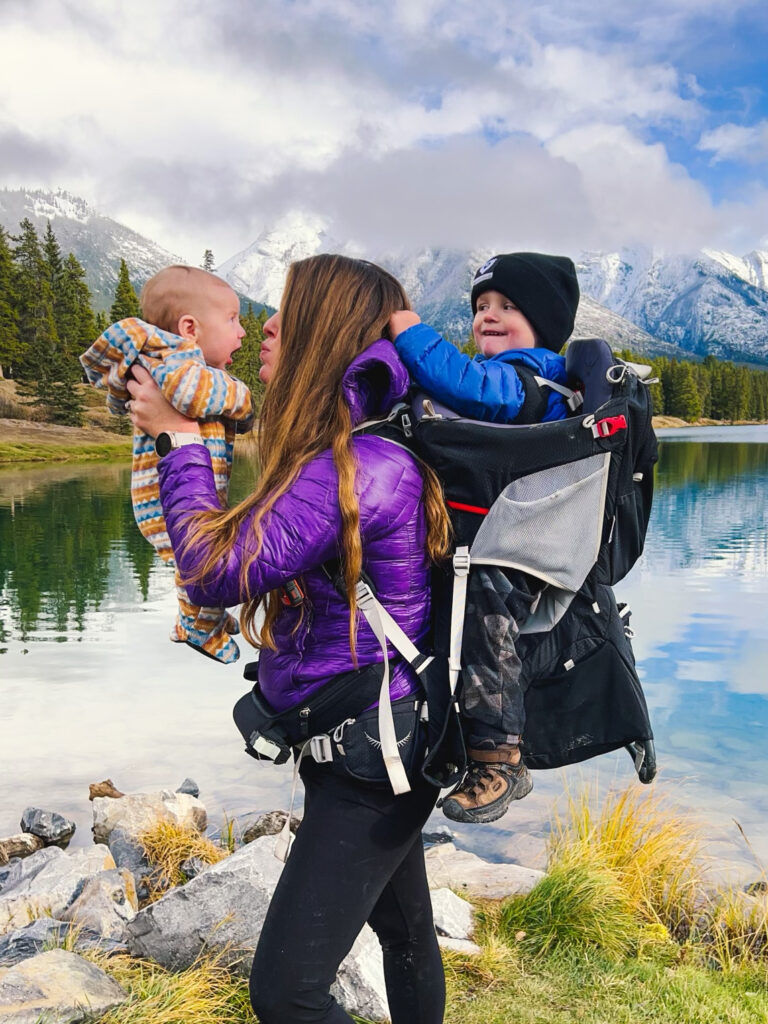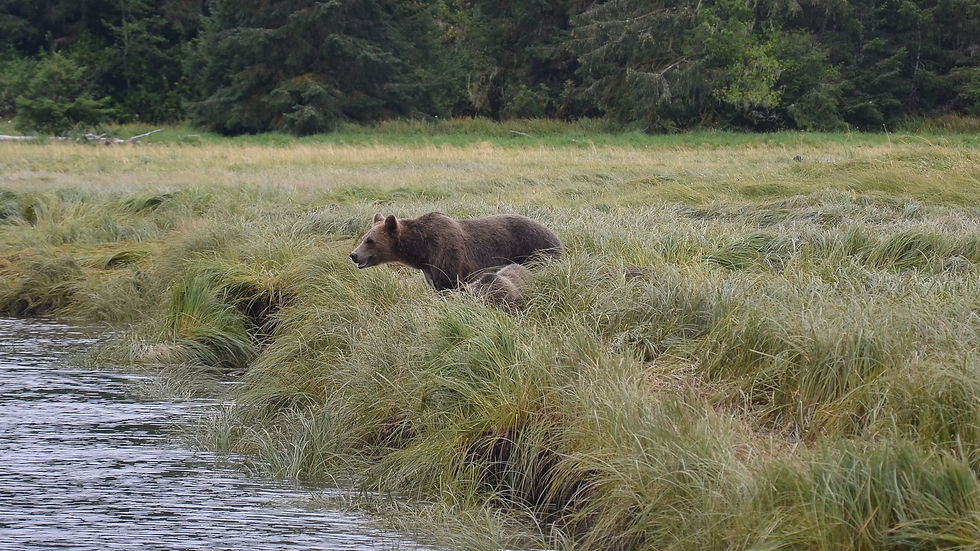
Picture this: It’s the middle of the night, the kids are sleeping, you’re tucked snugly in your sleeping bag, and it’s raining outside. The raindrops create a soothing pitter-patter on the canvas of the tent. It’s a picturesque moment and you’re cherishing it.
Until you notice the reason why you’re awake... You have to go to the bathroom. BADLY.
You come to the realization that you have to get out of the tent; you know you’re not going to make it until morning. Sleepily, you stagger outside, dressed just enough that you’re not “technically” running around the campground in your birthday suit. On the way to the bathroom, you see something in the bushes. Maybe it’s another sleepy midnight bathroom walker?
Not quite. Uh oh, it’s a bear.
Well, you’re not sleepy anymore! Your heart slams the gas pedal to the floor and you’ve kicked it into high gear. Do you run? Do you climb a tree? Do you scream? Good thing you have bear spray with you! Or… do you?
This little anecdote was inspired by a true story. Do you think he had bear spray? Did he know how to react in this situation? Luckily for all involved, this situation ended well. He was prepared and the bear was uninterested in a fight.
That’s not always the case, however! Would you have had bear spray? Do you know how to react? If not, we’re here to help! We’ve collaborated with Canadian Wild Animal Expert Kim Titchener, founder of Bear Safety & More Inc. and RecSafe with Wildlife, to help you navigate the wilderness and reduce your chances of an animal encounter.
In addition to this blog post, check out her website and sign up for a free community membership to access a library full of great free resources. Kim also offers amazing courses on bear safety and bear spray to educate you for all your adventures.
Animals Are Among Us

It’s important to note that no matter where you are, if you’re in nature, there are animals! They are all around us. When we go into the wilderness, we’re exploring in their home. It’s not a guarantee that you’ll have an animal encounter while you’re camping or exploring, but in one form or another, you’re going to see a wild animal (even if it’s just a squirrel or fox).
Education is key to a successful outcome with wildlife. If you’re heading out, please know which animals are common to the area, how to reduce your chances of having an encounter, and what to do if you have one! In short: be prepared.
Animal Encounters Are Increasing

A combination of animal habitat reduction and human population increases have resulted in more animal encounters over the years. COVID-19 has also given people more opportunities to “explore their backyard”, and while that is great, people are diving in uneducated and more and more people are ending up hurt-- or worse.
But don’t panic! While we always prepare for encounters and fear that if we step into the wilderness we’re going to get mauled by a bear, rest assured, these attacks are still extremely rare and there’s a lot we can do to reduce the chance of having conflict! Let’s learn how to reduce the chance of a conflict and how to handle an encounter should one occur.
Preventing Animal Encounters While Exploring and Hiking

While you’re in bear country with kids, there are a few important things to remember. First, make sure not to let your kids explore farther than an arm's length away from you! You have to be able to reach them to protect them. Additionally, keep your dogs on leash at all times! Believe it or not, children and dogs actually increase the chances of an encounter since they move erratically, and carnivores view them as prey.
Next, let those kids be LOUD! Make as much noise as you can while on the trail. Sing songs, hoot & holler, and make sure you join in with your kids. Animals, especially during early and late seasons, can be distracted while eating, and surprising an animal is a common cause for an encounter! Travel in groups of 4 or more as well, animal attacks are easily prevented by exploring in COVID-19-approved groups.
Also, be aware while you’re adventuring. Wildlife usually leave signs that they’re around. Some signs of a bear in the area are scat, tracks, dens, torn-up trees and logs, and digging. If berry bushes are in the area as well, assume a bear might be there too. If you spot signs of an animal, for the safety of your family and the animal, please leave the area! Carry bear spray in a holster on your body and be ready to use it, especially after seeing signs.
Preventing Animal Encounters While Camping

When front-country camping, always ask yourself:
How equipped is the campground for bear prevention? These items include bear-safe garbage bins, a bear locker, or can you store your food in your vehicle away from your sleeping area?
If the campground isn’t equipped, are you? Without safe storage at the campground, you may need to tie your own bear hang or use a bear keg.
If neither you nor the campground is equipped, there aren’t many options. It’s better to find a different campground and/or invest in a bear hang/keg. Don’t try your luck!
When arriving at your campground, take note:
Is the area full of anything that could attract a bear? This could include leftover garbage on the ground, in the fire pit, or in trees or nearby food sources for animals (such as berry bushes or water with salmon for bears).
Does it look like animals have been feeding in the area? Look for bear scat and shredded garbage.
Are there birds of prey flying over your campsite or feeding on the ground?
If Prevention Isn't Possible: Handling an Encounter in Bear Country with Kids

There are two types of bear encounters: Defensive and Non-defensive encounters.
Defensive Bear Encounters
These encounters can be caused by surprising a bear at close range, if cubs are present, or if the bear is feeding. These bears want to protect themselves or their precious cargo and will become defensive.
What does a defensive bear look like? These bears are clearly stressed out, aggressive, huffing/jaw popping, salivating/foaming, hunched up, and showing clear signs of discomfort. Defensive bears can also “bluff” charge or run in a zig-zag pattern to let you know that they want you out of the area.
So, it may be your instinct to yell, act big, and become aggressive too. Please don’t! React by telling the bear you are NOT a threat. De-escalate the situation, back away slowly, talk softly, and prepare your bear spray. If in a group, group up and stay calm. Make your intention to leave the area and not to fight.
If the bear attacks, the number one reaction from you is to deploy bear spray. If that’s not possible, lie face down and protect your neck, spread your legs (to brace yourself into the ground), and play dead. Wait until the bear is gone before getting up! Make sure once you begin to move again, you know which direction the bear has travelled to avoid another encounter.
Most defensive attacks are short. If it continues to attack and the bear has become predatory, you need to change tactics and begin to fight for your life.
Defensive bear encounters are more common and are more often due to not making noise and accidental encounters.
Non-defensive (Predatory) Bear Encounters
This encounter is rare but more common with black bears and solo hikers. 95% of grizzly bear encounters are defensive, not predatory!
Bear follows a person, and has a slow, hesitant approach. They can approach confidently, or try to sneak up on you before running towards you and attacking. They appear curious, but this is the situation where they are dangerous!
If you’re in a predatory encounter, show aggression right away! Stand your ground and make sure you let the bear know that you are not vulnerable.
Prepare bear spray and deploy if the bear gets close enough.
Bear Spray Basics

Always wear your bear spray on your body, easily within reach, such as in a holster. Never carry bear spray tucked in a backpack. Some animal encounters happen fast, and you won’t have much time to react!
Ensure each adult has their own can of bear spray. Practice pulling it out to gain muscle memory, so if you have to react in a real situation it won’t be the first time!
Does everyone who is carrying bear spray know when and how to use it? Read the instructions on the can before hitting the wilderness! To gain confidence in its use, take a bear spray class with Recsafe with Wildlife.
When in doubt, carry bear spray with you. Explore year-round with it, and carry it whenever and wherever you are if you’re in bear country!
Please Keep Exploring!

Exploring in nature is one of the most rewarding experiences. Despite probably being a little more nervous to get out and explore bear country since reading about bear safety (sorry), trust us, you’re better off if you’re informed! Please remember that these encounters are rare. Equip yourself with the knowledge and gear you need to stay safe, and you’ll feel much more comfortable out in the wilderness.
Have questions? Please reach out to us at Kids Who Explore or Kim Titchener at RecSafe with Wildlife and ask us! We’d love to help you answer questions and adventure more informed.
Disclaimer: The information we’ve provided you today, as well as the information from Bear Safety & More Inc and RecSafe with Wildlife, cannot guarantee that animal encounters can be prevented. This information is intended as a guide to help reduce the likelihood of an encounter and provide education in the occurrence of an encounter. Explore safely and have a wonderful time in the wilderness, explorers!
Comments